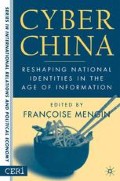Abstract
Since U.S. Secretary of State James Baker heralded the end of the Cold War in the Asia-Pacific with the earlier mentioned statement,2 the idea that the globalization of Information and Communication Technologies (ICTs) can transform an authoritarian state like China in harmony with American national interests has become something of a mantra for successive Washington administrations. In December 2000, U.S. President Clinton compared cracking down on the Internet in China with “trying to nail Jello to the wall.”3
… no nation has yet discovered a way to import the world’s goods and services while stopping foreign ideas at the border. It is in our interests that the next generation in China be engaged by the Information Age, not isolated from global trends shaping the future.
Access this chapter
Tax calculation will be finalised at checkout
Purchases are for personal use only
Preview
Unable to display preview. Download preview PDF.
Notes
J.A. Baker III, “America in Asia: Emerging Architecture for a Pacific Community,” Foreign Affairs, 70, 5 (February 1991): 16.
W.J. Drake, “Dictatorships in the Digital Age: Some Considerations on the Internet in China and Cuba,” iMP: The Magazine for Information Impacts (October 2000), URL (consulted November 2000): http://www.ceip.org.
M. Bacchetta, P. Low,A. Mattoo, L. Schuknecht, H. Wagner, and M. Wehrens, Electronic Commerce and the Role of the WTO ( Geneva: World Trade Organisation, 1998 ): 65.
M. Kantor, “Foreign Direct Investment in Chinese Telecoms: Changes in the Regulatory Scheme,” Cambridge Review of International Affairs, 13, 2 (2000): 147.
S. Breslin, “The Virtual Market,” China Review (Autumn/Winter 2000): 24.
D. Sutherland, “Policies to Build National Champions: China’s ‘National Team’ of Enterprise Groups” in China and the Global Business Revolution, Peter Nolan (ed.) ( Basingstoke and NewYork: Palgrave, 2001 ).
P. Nolan and M. Hasecic, “China, the WTO and the Third Industrial Revolution,” Cambridge Review of International Affairs, 13, 2 (2000): 167–69.
L. Lessig, Code and Other Laws of Cyberspace ( NewYork: Basic Books, 1999 ): 39–42.
J. Naughton, A Brief History of the Future: The Origins of the Internet ( London: Weidenfeld and Nicolson, 1999 ).
C. Zhang and J. Ni, Guojia Xinxi Anquan Baogao (Report on National Information Security) (Beijing: Renmin Chubanshe, 2000 ): 35, 52.
P. Keller, “China’s Impact on the Global Information Society,” in Regulating the Global Information Society, Christopher T. Marsden (ed.) ( London and New York: Routledge, 2000 ): 267.
B. Schneier, Secrets and Lies: Digital Security in a Networked World ( New York: John Wiley and Sons Inc, 2000 ): 21.
H.H. Frederick, Global Communication and International Relations ( California: Wadsworth, 1993 ): 245.
C. Zhang and J. Ni, Guojia Xinxi Anquan Baogao ( Report on National Information Security) (Beijing: Renmin Chubanshe, 2000 ): 271–92.
T. Mathiesen, On Globalisation of Control: Towards an Integrated Surveillance System in Europe ( London: Statewatch, 1999 ): 31.
G.D. Grove, S.E. Goodman, and S.J. Lukasik, “Cyber Attacks and International Law,” Survival, 42, 3 (2000): 99–100.
Liao, Minru, “Liang an haike zhan—bu fen wangyou fen tingzhi” (cross-straits Hacking War— Some Hackers Want to Call a Stop) Lianhe Bao (United Daily News, Taiwan—overseas edition) (August 14, 1999 ): 3.
Christopher R. Hughes, “Nationalist Chat,” The World Today, 57, 6 (2001): 6–8.
Louis Althusser, “Ideology and Ideological State Apparatuses,” in Lenin and Philosophy and Other Essays (Vol. 3 ) ( New York: New Monthly Review Press, 1978 ): 244.
Christopher R. Hughes,“Nationalism in Chinese Cyberspace,” Cambridge Review of International Affairs, 13, 2 (2000): 195–209.
D. Zinnbauer, “Whither the Panopticon?: Civil Society Activism and State Surveillance in the Age of the Internet, Some Evidence From Malaysia,” research paper delivered to Development Studies Institute, L.S.E., November 2000: 28.
Manuel Castells, The Informational City ( Oxford: Blackwell, 1999 ): 21.
H.Bull, The Anarchical Society ( London: Macmillan, 1977 ).
Editor information
Editors and Affiliations
Copyright information
© 2004 Françoise Mengin
About this chapter
Cite this chapter
Hughes, C.R. (2004). Controlling the Internet Architecture within Greater China. In: Mengin, F. (eds) Cyber China. The CERI Series in International Relations and Political Economy. Palgrave Macmillan, New York. https://doi.org/10.1057/9781403979551_5
Download citation
DOI: https://doi.org/10.1057/9781403979551_5
Publisher Name: Palgrave Macmillan, New York
Print ISBN: 978-1-349-52912-4
Online ISBN: 978-1-4039-7955-1
eBook Packages: Palgrave Political & Intern. Studies CollectionPolitical Science and International Studies (R0)

